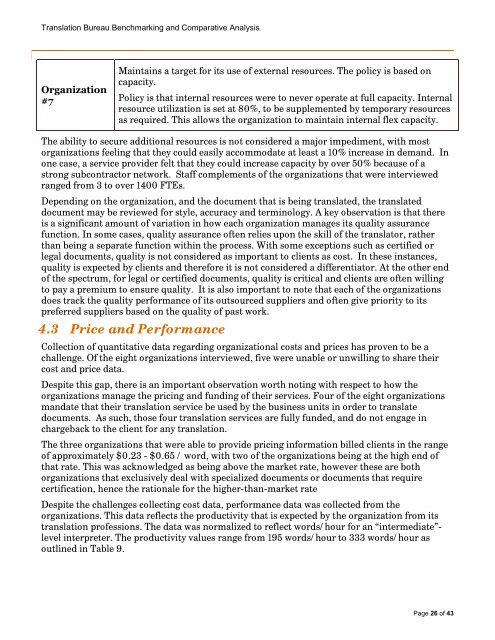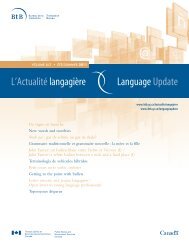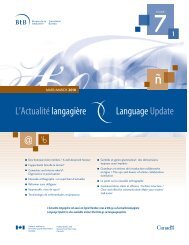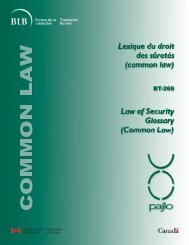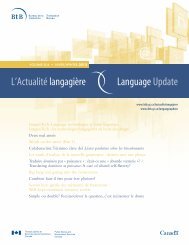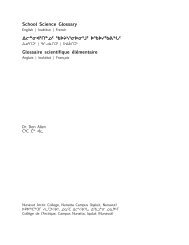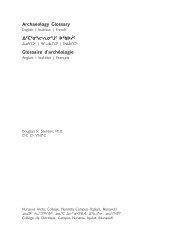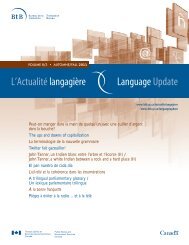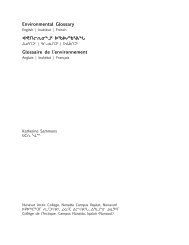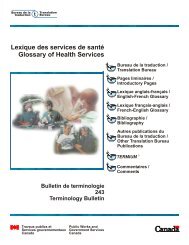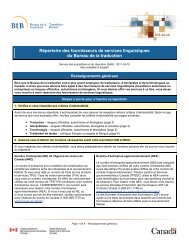Translation Bureau Benchmarking and Comparative Analysis - Final ...
Translation Bureau Benchmarking and Comparative Analysis - Final ...
Translation Bureau Benchmarking and Comparative Analysis - Final ...
Create successful ePaper yourself
Turn your PDF publications into a flip-book with our unique Google optimized e-Paper software.
<strong>Translation</strong> <strong>Bureau</strong> <strong>Benchmarking</strong> <strong>and</strong> <strong>Comparative</strong> <strong>Analysis</strong>Organization#7Maintains a target for its use of external resources. The policy is based oncapacity.Policy is that internal resources were to never operate at full capacity. Internalresource utilization is set at 80%, to be supplemented by temporary resourcesas required. This allows the organization to maintain internal flex capacity.The ability to secure additional resources is not considered a major impediment, with mostorganizations feeling that they could easily accommodate at least a 10% increase in dem<strong>and</strong>. Inone case, a service provider felt that they could increase capacity by over 50% because of astrong subcontractor network. Staff complements of the organizations that were interviewedranged from 3 to over 1400 FTEs.Depending on the organization, <strong>and</strong> the document that is being translated, the translateddocument may be reviewed for style, accuracy <strong>and</strong> terminology. A key observation is that thereis a significant amount of variation in how each organization manages its quality assurancefunction. In some cases, quality assurance often relies upon the skill of the translator, ratherthan being a separate function within the process. With some exceptions such as certified orlegal documents, quality is not considered as important to clients as cost. In these instances,quality is expected by clients <strong>and</strong> therefore it is not considered a differentiator. At the other endof the spectrum, for legal or certified documents, quality is critical <strong>and</strong> clients are often willingto pay a premium to ensure quality. It is also important to note that each of the organizationsdoes track the quality performance of its outsourced suppliers <strong>and</strong> often give priority to itspreferred suppliers based on the quality of past work.4.3 Price <strong>and</strong> PerformanceCollection of quantitative data regarding organizational costs <strong>and</strong> prices has proven to be achallenge. Of the eight organizations interviewed, five were unable or unwilling to share theircost <strong>and</strong> price data.Despite this gap, there is an important observation worth noting with respect to how theorganizations manage the pricing <strong>and</strong> funding of their services. Four of the eight organizationsm<strong>and</strong>ate that their translation service be used by the business units in order to translatedocuments. As such, those four translation services are fully funded, <strong>and</strong> do not engage inchargeback to the client for any translation.The three organizations that were able to provide pricing information billed clients in the rangeof approximately $0.23 - $0.65 / word, with two of the organizations being at the high end ofthat rate. This was acknowledged as being above the market rate, however these are bothorganizations that exclusively deal with specialized documents or documents that requirecertification, hence the rationale for the higher-than-market rateDespite the challenges collecting cost data, performance data was collected from theorganizations. This data reflects the productivity that is expected by the organization from itstranslation professions. The data was normalized to reflect words/hour for an “intermediate”-level interpreter. The productivity values range from 195 words/hour to 333 words/hour asoutlined in Table 9.Page 26 of 43


